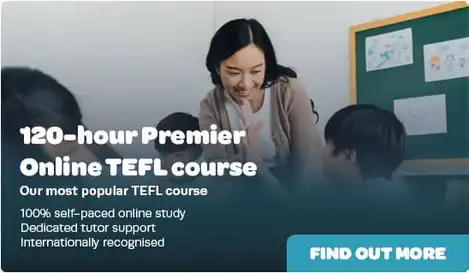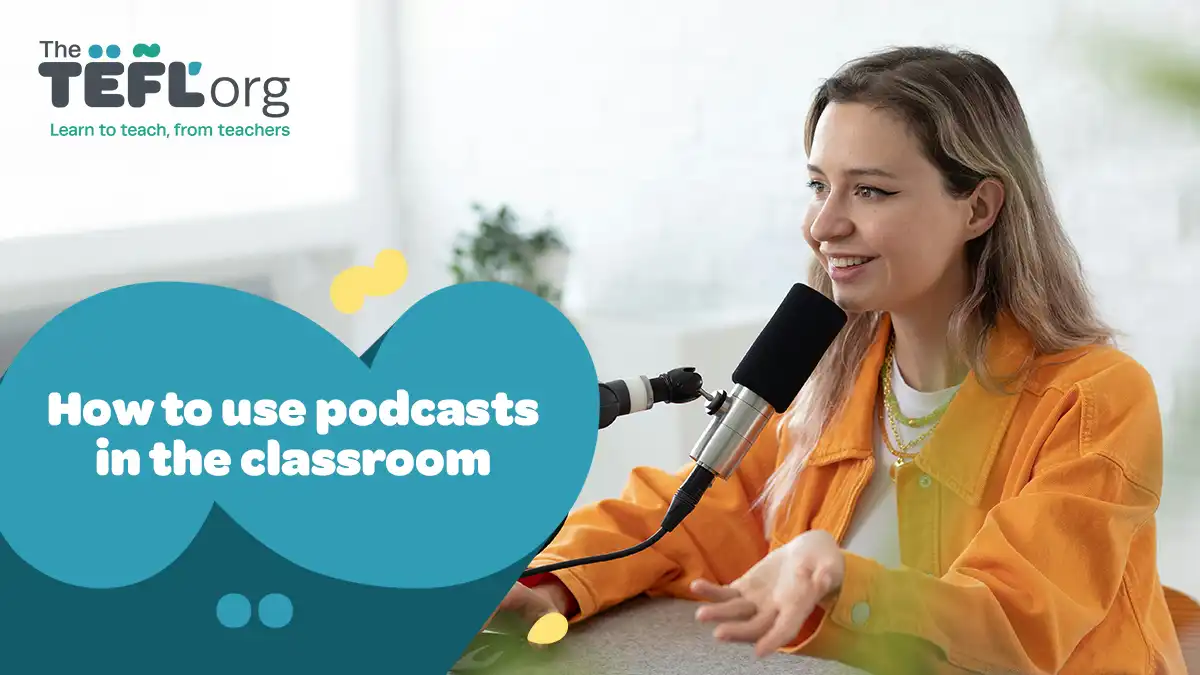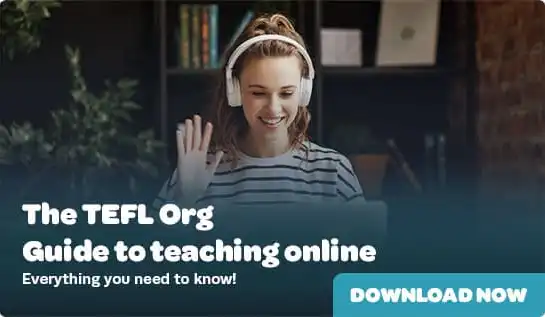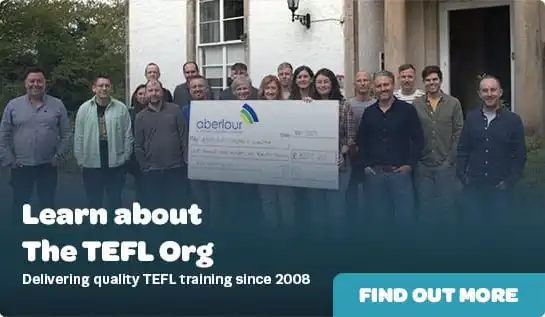- TEFL Courses TEFL Courses
- View all TEFL courses
- 120-hour Premier Online TEFL Course
- 250-hour Level-5 Online TEFL Course
- Online TEFL Courses
- Classroom TEFL Courses
- Combined TEFL Courses
- Virtual TEFL Courses
- TEFL Course Bundles NEW
- Advanced TEFL Courses
- TEFL Lesson Plans & Resources
- TEFL Gift Vouchers
- Which TEFL course is right for you?

- New to TEFL New to TEFL
- Locations
- TEFL Jobs
- Teach Abroad Teach Abroad
- Teach English Abroad
- Teach English in Japan
- Teach English in South Korea
- Teach English in Spain
- Teach English in China
- TEFL Salaries Abroad
- Requirements for teaching abroad
- Teach English abroad without a degree
- How to find teaching jobs abroad without experience
- Can you teach English abroad as a non-native speaker?

- Teach Online
- About Us
- Blog
- Podcast

How to use podcasts in the classroom
Nowadays, everyone has a raft of podcasts to recommend to you. Across genres, it can honestly feel impossible to keep up sometimes - the level of quality and quantity has exploded over the last decade. Nearly everyone you know has a favourite you’ve likely never heard of, and it’s hardly your fault, because there’s so much out there!
In fact, there are over 4 million registered podcasts out in the world. In the US alone, podcast listenership is just under 100 million a week , with the expectation that the number of people listening to podcasts will only continue to grow.
We even have an extremely good podcast, if you don’t mind us saying, called I Taught English Abroad . It tells the stories of TEFL teachers who have worked here, there and everywhere, with amazing stories to tell. So, everyone’s at it!
How, though, can podcasts be utilised in the TEFL classroom? How can this exciting, new(ish) medium be used to boost proficiency, and even become a fantastic creative task for your English students?
Let’s take a look at how, just like drama and music , podcasts can be used as a force for TEFL learning.
Using podcasts to inform
Perhaps the most obvious way to use podcasts as a learning tool is by using them to inform. Close reading exercises are tried and trusted as a way of boosting proficiency, so why not close listening?
Picking a podcast about a specific topic, teaching some key phrases to listen out for beforehand, and picking out a segment to play to a class or an individual learner can be an excellent lesson. It helps to teach specific phrases or pronunciations, you can provide question sheets about the audio clip in question, or you can ask students what they thought about the clip, based on their interpretation of what was said.
Students can build their vocabulary and react subjectively to stimuli in English. These are important building blocks in language learning. What’s more, if you’re teaching a class or individual a specific type of English - for example, Business English , or another topic they specifically want to cover like politics or soccer - you can hone in on specific vocabulary they want to learn and use.
It’s all about reaction, understanding and participation. Did your student understand the clip? Do they have an opinion about what they’ve heard? What can they tell you about it? From there, a conversation can grow, and the learning experience becomes more participatory.
Using podcasts as a creative exercise
Hear us out - no pun intended - but have you considered making a podcast with your students?
Nobody is expecting a fully edited, seamless podcast from your students - something like I Taught English Abroad , for example. However, even with limited proficiency in English, giving your students a fun topic to cover, and recording a conversation, can be an excellent speaking exercise.
As a teacher, you can grade students on their fluency, pronunciation and the originality of their statements. By giving students time to research what they want to say, and the arguments they want to make, you can emphasise the importance of self-directed study .Podcasts are also a great way to get your students in groups, and to discover or nourish any hidden talents. For example, who’s good at presenting? Who can write a theme song? Who’s best at podcast editing, but didn’t know they were able to do it? There are a plethora of skills students can develop - some they know they have, and others they’ll learn about.
Listening back to these mini-podcasts as a class, and allowing for peer-led feedback, is also massively beneficial. The whole class can learn plenty from each other, from a technical standpoint and from an English learning perspective. There’s a lot to mine here from what is a surprisingly straightforward activity, especially with the technology available to students these days. Free editing tools, digital audio workstations (DAWs) and other software can help give the podcast a professional sheen, while for recording, most smartphones are now pre-loaded with quality microphones.
Creative solutions are the future!
Creative lessons like these, using new forms of media, are the way forward. While some of the traditional methods of learning work fine, young learners will react well to new forms of media, including TikToks and podcasts. These platforms are a help, not a hindrance - though if you hear TikToks blaring out of someone’s phone during a quiet moment in class, that’s a different story!
Encouraging your students to pursue interests in English-language contexts is always a good idea. From deciphering lyrics to politics, and translating recipes to watching sportspeople’s press conferences, listening and reading exercises from a range of creative, less orthodox platforms are a great way to engage students with a range of scenarios in English.
Meanwhile, encouraging students to use English creatively, through projects like podcasts, poster designs, arts and crafts, presentations and debates allows learners to engage with the language differently. By seeking out the vocabulary and pronunciation they need for certain contexts, they can embed phrases and areas of language they’re particularly interested in, and connect the fundamental grammatical dots along the way.
As Betsy Potash told us on I Taught English Abroad :“As a teacher, I'm looking to create that kind of experience for my students. How can I make the learning feel like it's going to be relevant to their future life?
It means something. It's not just for me, it's for their community, or it's for their peers, or it's because they're really passionate about the subject.
And I find that the skills of English and language, writing, speaking, really lend themselves to that. It's not necessarily about specific content. It's about how you are engaging with that content, and how you're creating based on that content. And that's what I love to do, is create experiences where students can have that moment.”
Boost proficiency with podcasts
Have we convinced you, yet?
Podcasts can be used both objectively and subjectively. Students can learn English language skills, hear different accents and dialects, hear how grammar is used by English speakers, and get more of a feel for the language in practical terms. They can also, through listening exercises, hear opinions and analysis - in English - that they agree or disagree with, analyse and study.
Just like using television, radio or film, podcasts are a fantastic learning tool, but unlike more traditional forms of media, podcasts are incredibly easy to make. You can make 5-10 minute podcasts with your students, featuring theme music, a range of voices and topics, a presenter and someone editing and mixing the audio. In one class, you can help students discover skills they never thought they had, and establish long-term career goals. Not bad at all for one creative exercise!
Podcasts: not just fun to listen to, but fun to use in the classroom, and fun to make! Just know that, given how many there are, you’ll never be fully caught up with all of them. We’re sorry!
Feeling inspired, and want to get your start in TEFL teaching? It can all begin today, with a TEFL course from the most accredited course provider on the planet!










